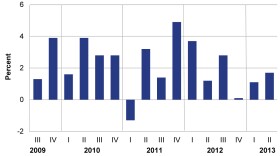The unemployment rate only includes people who don't have jobs and are looking for work. A much larger swath of people — about 36 percent of U.S. adults — don't have jobs and aren't looking for work at all. That figure is higher than it's been in decades (and, conversely, the share of adults in the labor force — shown in the graph above — is lower than it's been in decades).
Here are four reasons why so many people are leaving the labor force.
1. They're retiring.
The baby boomers are hitting retirement age. Even if the job market were in good shape, that alone would be enough to drive up the share of adults who aren't looking for work.
2. They're going to college.
College enrollment is up — and many students are having a hard time finding part-time work. A 20-year-old student named Jeannett Llave told me the last job she applied for was working at the American Girl doll store in New York. "I thought I was perfectly fine and capable of taking care of little girls and, like, just giving them a doll," she told me.
She didn't get the job — and she decided to give up looking and focus on her anatomy class. Because it's been more than a month since Llave looked for a job, she's not counted as part of the labor force.
3. They're staying home with the kids.
In the 1970s and '80s, the labor force participation rate rose sharply, as it became more common for mothers to work. Some of the recent decline has come as parents in dual-income households decide that the cost of day care outweighs the benefits of work.
I talked to one stay-at-home dad who worked in a newsprint factory in Columbia, Mo., making $9 an hour. Now, his wife works as a doctor and he stays home with his 7-year-old daughter.
4. They just can't find work.
"I think at last count I had sent out like 185 resumes or responded to 185 actual openings," Terri Meier, who used to work in human resources at Sony, told me. "And of that, I've gotten two opportunities where I actually went to a live interview."
Meier has been out of work for three years, and she's what the Labor Department calls "marginally attached" to the labor force. Because she hasn't actively looked for a job in the last four weeks, she's not counted among the unemployed.
But she wants to work, and she's looked for a job in the past year. Some 2.5 million Americans fit this description.
Copyright 2023 NPR. To see more, visit https://www.npr.org.






